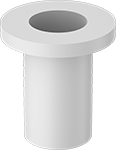Filter by
Material
Color
Washer Type
Edge Type
Performance
Maximum Temperature
System of Measurement
Minimum Temperature
Export Control Classification Number (ECCN)
REACH
RoHS
DFARS Specialty Metals
Hardness
Insulating Sleeve Washers
Cover screw threads to stop electrical current in its tracks and prevent short circuits. These washers create a barrier between the screw threads and the mating surface when mounted in through holes. This barrier also extends the life of your assembly by preventing galvanic corrosion, which is when two different metals rust more quickly due to contact with each other.
Flat Edge
 |
The flat edge distributes weight evenly to take pressure off screw heads.
Hard Fiber—The least likely to scratch or mar delicate mounting surfaces, such as printed circuit boards. These washers provide a moderate amount of electrical insulation, but they don't block current as well as plastic or ceramic washers.
Sleeve | Temp. Range | ||||||||||||||||||||||||||||||||||||||||||||||||||||||||||||||||||||||||||||||||||||||||||||||||||
|---|---|---|---|---|---|---|---|---|---|---|---|---|---|---|---|---|---|---|---|---|---|---|---|---|---|---|---|---|---|---|---|---|---|---|---|---|---|---|---|---|---|---|---|---|---|---|---|---|---|---|---|---|---|---|---|---|---|---|---|---|---|---|---|---|---|---|---|---|---|---|---|---|---|---|---|---|---|---|---|---|---|---|---|---|---|---|---|---|---|---|---|---|---|---|---|---|---|---|---|
For Screw Size | Ht. | OD | ID | OD | Thk. | Overall Ht. | Min. | Max., ° F | Color | Pkg. Qty. | Pkg. | ||||||||||||||||||||||||||||||||||||||||||||||||||||||||||||||||||||||||||||||||||||||||
Hard Fiber | |||||||||||||||||||||||||||||||||||||||||||||||||||||||||||||||||||||||||||||||||||||||||||||||||||
| No. 2 | 0.025" | 0.154" | 0.090" | 0.250" | 0.030" | 0.055" | Not Rated | 230 | Black | 50 | 93920A110 | 000000 | |||||||||||||||||||||||||||||||||||||||||||||||||||||||||||||||||||||||||||||||||||||||
| No. 4 | 0.025" | 0.186" | 0.116" | 0.250" | 0.030" | 0.055" | Not Rated | 230 | Black | 50 | 93920A120 | 00000 | |||||||||||||||||||||||||||||||||||||||||||||||||||||||||||||||||||||||||||||||||||||||
| No. 6 | 0.030" | 0.186" | 0.142" | 0.313" | 0.040" | 0.070" | Not Rated | 230 | Black | 50 | 93920A130 | 0000 | |||||||||||||||||||||||||||||||||||||||||||||||||||||||||||||||||||||||||||||||||||||||
| No. 8 | 0.030" | 0.246" | 0.168" | 0.375" | 0.040" | 0.070" | Not Rated | 230 | Black | 50 | 93920A140 | 00000 | |||||||||||||||||||||||||||||||||||||||||||||||||||||||||||||||||||||||||||||||||||||||
| No. 10 | 0.030" | 0.312" | 0.194" | 0.375" | 0.040" | 0.070" | Not Rated | 230 | Black | 50 | 93920A150 | 00000 | |||||||||||||||||||||||||||||||||||||||||||||||||||||||||||||||||||||||||||||||||||||||
| 1/4" | 0.030" | 0.312" | 0.254" | 0.500" | 0.040" | 0.070" | Not Rated | 230 | Black | 50 | 93920A160 | 00000 | |||||||||||||||||||||||||||||||||||||||||||||||||||||||||||||||||||||||||||||||||||||||
| 3/8" | 0.040" | 0.437" | 0.380" | 0.625" | 0.060" | 0.100" | Not Rated | 230 | Black | 50 | 93920A170 | 00000 | |||||||||||||||||||||||||||||||||||||||||||||||||||||||||||||||||||||||||||||||||||||||

























